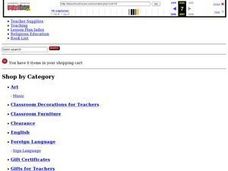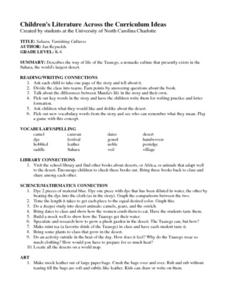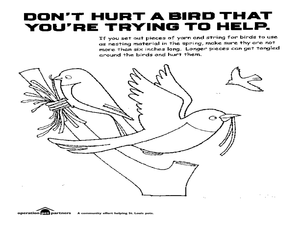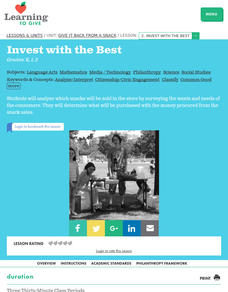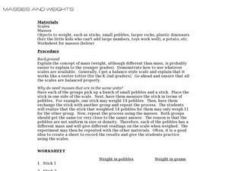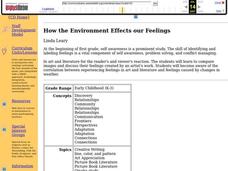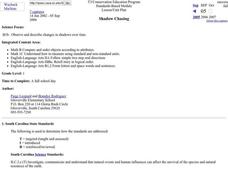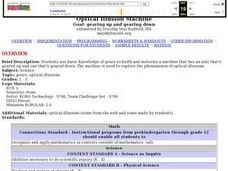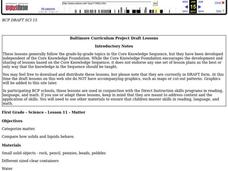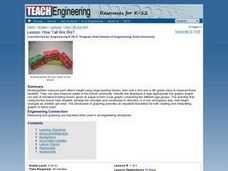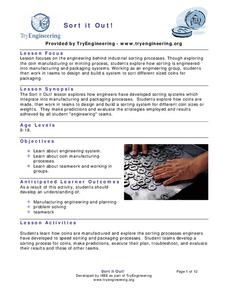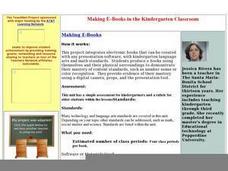Curated OER
What Comes From Corn
Students name and examine various items that are made from corn. Students compare ears of corn to Indian corn, and cook several items made from corn. Students create a popcorn picture and illustrate a book.
Curated OER
Sorting Lids
Young scholars practice sorting lids in different ways so that each group determines a sorting pattern. They examine how to work in groups while sharing ideas. They establish group work relationships that become apparent to the teacher...
Curated OER
Children's Literature Across the Curriculum Ideas-Sahara, Vanishing Cultures
Pupils read Sahara, Vanishing Cultures by Jan Reynolds. They complete a variety of cross-curricular activities surrounding the study nomadic cultures. Included are reading, art, math, science, writing, social studies, and library...
Curated OER
This is for the Birds!
Learners complete activities to investigate wild birds. For this bird study lesson, students make a wild bird feeder to examine the proper ways to care for wild birds. Learners explore organizations in their community that help wild...
Curated OER
Give It Back From a Snack Lesson 2: Invest With the Best
Students survey schoolmate as to what type of snacks they would prefer to purchase. They graph the results and apply them to planning a classroom snack sale while examining what wants, needs, and consumers are.
Curated OER
Masses and Weights
Students explore the concept of weight and mass and the importance of units. Using a balance, they determine the weight of various objects in the unit of "pebbles" and in grams.
Curated OER
Match One to One
In this matching pictures worksheet, students must recognize the animals and then draw lines to match the like animals one to one.
Curated OER
Match One to One
In this animal recognition worksheet, students draw lines to match the like animals that are the same to each other. Students match squirrels, bears, deer, skunks, and birds.
Curated OER
Com-Post With Us? Learn About Recycling While Having Fun
Young scholars examine the importance of recycling to help the environment. In groups, they make a compost bin on the school grounds recording how the material changes from week to week. They collect other materials for recycling like...
Curated OER
Rainforest
Students create a rainforest poster and move to music learning about the rainforest. For this rainforest lesson plan, students express themselves in a variety of ways using their knowledge of the rainforest. Activities include creating a...
Curated OER
H2O in Us
Students discover through this activity that all organisms are composed of water. They find that 70 percent of their bodies are made up of water that is in thier cells and blood, and not free-flowing throughout their body.
Curated OER
DAY AND NIGHT
Students use a lamp as the sun and his/her body as the earth. They rotate in different directions to explain how the earth moves around the sun. Using specific questions in their discussion, students discover the reasons for day and night.
Curated OER
How the Environment Effects our Feelings
First graders compare images and discuss their feelings created by an artist's work. They explore the correlation between experiencing feelings in art and literature and feelings caused by changes in weather.
Curated OER
Shadow Chasing
First graders observe and measure their shadows. They go outside at three hour increments during the course of a day. Each time students measure and record the length of their shadows. Students read books about shadows and discuss why...
Curated OER
The Nature of Mathematics
Young scholars work in groups to describe plants using numbers. In this number lesson, students use numbers to define plants and then use numbers to write descriptions of themselves.
Curated OER
Optical Illusion Machine
Students explore optical illusions. Using Legos, they construct and motorize a machine that has an axle that's geared up and geared down, complete a worksheet, and answer discussion questions.
Curated OER
Rubber Gardens
Students recycle discarded automobile tires and create gardening sites for limited space areas.
Curated OER
A Worm World
Young scholars maintain a compost bin and build a worm observatory. They design experiments relating to worms and record observations in a worm journal.
Curated OER
How Tall Are We?
Students in a Kindergarten class measure each other's height using large building blocks and then visit a 2nd and a 4th grade class to measure those students. They display the results in bar graphs, comparing the different age groups.
Curated OER
Sort It Out
Students study classification systems by sorting Legos and determining how the different pieces are classified. They list as many attributes as possible to use for sorting.
Curated OER
Spiders
First graders complete a variety of center activities to study spider characteristics and facts. They solve math problems, identify spider body parts, and study vocabulary words to use in creative writing about spiders.
Curated OER
Making E-Books in the Kindergarten Classroom
Students produce e-books using themselves and their physical surroundings to demonstrate content standards, such as number sense or color recognition. They provide evidence using a digital camera, props, and the presentation tool.
Other popular searches
- Math and Science Careers
- Integrated Math and Science
- Science and Math
- Science/ Math Games
- Math and Science Activities
- Integrating Math and Science
- +Math and Science Careers
- Math and Science Plan
- Math and Science Lessons
- Word Origins Science Math
- Math in Science Experiments
- Science Math

